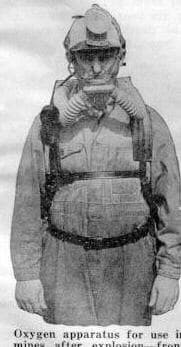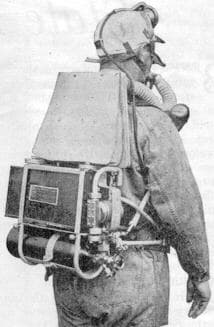

Mine rescue teams were first organized in West Virginia in 1917. This was in response to the many disasters and the high accident rates common in the mines at that time. Fatal accidents averaged more than one per day beginning in 1914. The photos below show a mine rescue team member outfitted in rescue gear in approximately 1924. To see additional historic mine rescue photos go to Historic WV Mine Rescue Photos.
The current WV Mining Law, (22A-1-35) requires each operator to provide mine rescue coverage at each active underground mine. The operators can establish their own teams or contract for the service from a vendor. The act also details the requirements for mine rescue team training and establishes performance requirements. The law stipulates the requirements for equipping the mine rescue stations and the maintenance of the rescue equipment. It also provides for regular inspection of the station and equipment.
Team members take classes in techniques for entering mines following explosions, cave-ins and other accidents. They also receive in-depth training with regard to mine maps and ventilation procedures and the use of auxiliary mine rescue equipment. Mine rescue teams are highly proficient in their work and take great pride in their skills. It is highly dangerous work because they can never be sure if there will be explosions or cave-ins after they enter a mine. There could be poisonous gases that will kill them in seconds. Each member is equipped with a special breathing apparatus and other safety gear.
Once suited up, a rescue worker’s equipment load pushes 50 pounds, with a cap-light, battery and belt with tools. Additional equipment includes testers to detect methane, oxygen, carbon monoxide and other various poisonous and noxious gasses. If the atmosphere is found to be breathable in places, the four-hour oxygen supply will last for a six-to eight-hour shift. The torturous footing involves anything from mud and water to downed timbers and roof falls. Sometimes the atmosphere resembles that of another planet, with poisonous amounts of carbon monoxide and explosive layers of methane.
Mine Rescue Contests
Gallery – Fallen Heroes Mine Rescue Competition – September 2025
Mine rescue teams train and practice regularly to make sure they are prepared in the event of an accident. As a part of their training, teams from different mines and companies, and from different states, compete for championships and trophies. These contests are highly competitive as the teams try to solve “problems” assigned to them by the contest officials. Mine Rescue contests are held periodically throughout the summer months. The contests are a valuable adjunct to the regular training of these teams. The contests are divided into the following modules: Mine Rescue, First Aid, Bench, and EMT.
Pre-Shift Contest
Recently, many contests have added the Mine Foreman’s “Pre-shift” as a separate contest. This contest tests the skills of mine foremen performing pre-shift examinations.
The Bench Contest
Benchmen are pivotal members of mine rescue teams who do maintenance and repair on the portable oxygen devices worn by rescue teams. Their part of the contest is to diagnose and repair two breathing apparatuses in 30 minutes while judges and co-workers watched intently. It takes full concentration and a little bit of an athlete’s luck to find them all, do repairs, and do it fast enough to win.
How well and how fast Benchmen can test and maintain a breathing apparatus is at the heart of every mine rescue operation. As team members return from their shift, the self-contained, regenerative, oxygen-breathing apparatuses, including all of their various components, must be tested and must be made ready to be used once more.
Team Composition
In West Virginia, there are currently fourteen (14) mine rescue teams. For competition purposes, these teams are composed of up to eight team members consisting of: 5 working team members, a briefing officer, and 2 alternates. WV Code (22A-1-35(f)) stipulates that “Each mine rescue team shall consist of five members and one alternate, who are fully qualified, trained, and equipped for providing emergency mine rescue service.”
Read these two news articles concerning unique training for West Virginia mine rescue teams.
Team Member Requirements
In West Virginia, an applicant for initial mine rescue training shall have been employed underground for a total of one year or more within the three preceding years. The applicant must undergo a physical examination by a licensed physician within thirty days prior to initial training. Initial training consists of a 31-hour course of instruction that thoroughly acquaints the applicant with the use, care, and maintenance of the apparatus that will be used. The applicant must pass a practical examination at the conclusion of training. The applicant must also possess a current first-aid training certificate. Upon completion of initial training, each mine rescue team member must receive at least forty hours of refresher training annually, which can be administered four hours every month or eight hours every two months. If the type of breathing apparatus used is changed, each team member must receive an additional eight hours of training in the use, care, and maintenance of the new apparatus.
If you have questions or need additional information, send an email to: wvminerescue